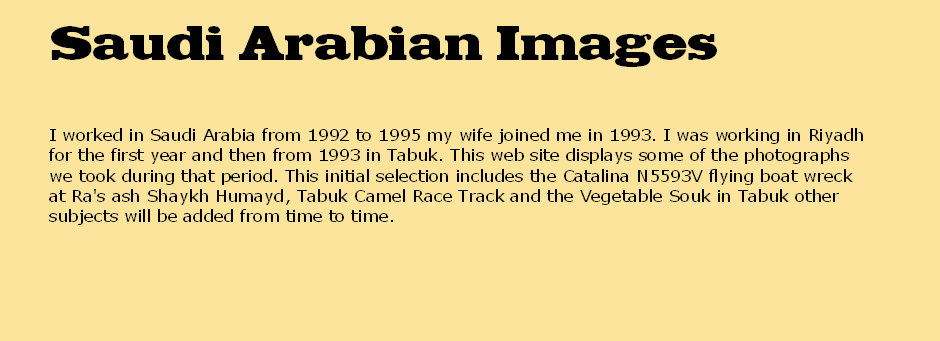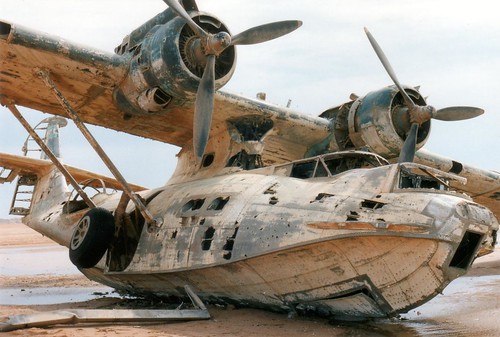Catalina Flying Boat N5593V
The Catalina has lain abandoned for over 50 years on the beach off the Strait of Tiran on the Saudi Arabia side of the entrance to the Gulf of Aqaba. The aircraft is a PBY-5A model and was bought from the US Navy by Thomas W Kendall, a retired businessman who converted it to a luxury flying yacht.
“Last spring Thomas Kendal, a retired Californian industrialist of 44 started a leisurely trip around the world in a PBY amphibian that he had converted into a lavish flying yacht. Kendal’s party consisted of his wife Miriam, his children - Bob, 24, Susan, 15, Paul, 11 Kathy, 9 - his secretary Ramona Shearer, and her son Stephen, 11. Photographer David Lees joined the group during the trip to record part of it for Life. One evening a few weeks ago Kendall landed on the Gulf of Aqaba in the middle east and the pleasure trip turned into a harrowing, almost fatal adventure, which he describes in the following article.” This is the introduction to the article written by Thomas W Kendal in the magazine Life.
Below is a brief summary of the article, the full article can be read in the edition dated 30th May 1960 of the magazine. Some of David Lees’ original photographs can be seen together with other original photographs of the aircraft including the luxurious interior on the Pinterest.
On the 22nd March 1960 Thomas Kendall landed at the Strait of Tirana and anchored the aircraft a short distance from the shore to spend the night there. They heard someone shouting but did not pay any attention. In the afternoon of the following day they were attacked with machine guns and automatic firearms from a headland nearby. The children were able to swim back to the aircraft. Mr Kendal and his secretary were wounded while trying to start the Catalina but moved it about 800 metres, unfortunately it ran aground on a coral reef. The firing lasted 30 to 40 minutes and no fewer than 300 shots hit the aircraft. The fuel tanks were perforated and 4000 litres of fuel poured from the holes but miraculously the aircraft did not catch fire. The sea was only about 1.5 metres deep and all aboard managed to leave the aircraft and reach the shore. On the beach they were captured by a group of Bedouins attached to the Saudi Arabian army, who had taken them to be Israeli commandos. They were eventually taken to Jeddah, interrogated and finally set free with the help of the American Ambassador. The Ambassador protested to the Saudi Arabian government but they refused to accept any liability for the attack and consequent loss of the aircraft.
Our photographs were taken in February 1995 when with my wife and a small group of friends I visited the site. We had to make a hurried exit when the local coast guard spotted us. Click on the photograph at the top to see the full set of images. A short video shot during our visit can be found on Youtube.
The flying boat is now in an even worse state of dilapidation and more recent photographs can be found on the Mekshat web site It is an Arabic web site, images can be found by scrolling down.
At the beginning of the journey the aircraft landed at Croydon Airport, London. A photograph of the aircraft standing at the airport can be seen on the Croydon Airport website. The only surviving UK flying Catalina is based at Duxford. Details can be found on the Catalina Society website.
The wreck can also be viewed on Google Maps satellite images
Catalina N5593V featured in the film SOS Pacific. The film was made in 1959 and issued in 1960 and starred among others Richard Attenborough. A still shot from the film of the inside of an aircraft, probably a studio mock up, can be seen at the British Films website.
Thomas Kendall was from Los Angeles and a retired manufacturer of air-conditioning equipment. He purchased two Catalina PBY flying boats from the US navy in 1956. The second PBY was donated to the San Diego Air and Space Museum in January 1986 by the Thomas W Kendall Family. The Catalina is now displayed in the Museum's Edwin D. McKellar Pavilion of Flight. Photographs of the inside of the PBY can be seen on the museum’s facebook page.
Technical Information
The Convair PBY-5A Catalina were developed from the PBY-5A flying boat and used by numerous air forces. They were built by Boeing Aircraft of Canada, Canadian Vickers and the Naval Aircraft factory using two Pratt and Whitney R-1830-92 engines. Maximum speed 190 mph. Cruising speed 125 mph. Service ceiling 15800 ft. Range 2,520 miles. Weights, empty 17,564 lb, loaded 34000 lb. Dimensions, Span 104 ft., length, 63 ft. 10 in. Height, 18 ft. 10 in.
Source: Observer Book of Aircraft, 1956 edition.
A comprehensive history with specifications of the PBY Catalina can be found on Wikipedia.
This incident is also included in Consolidated PBY Catalina: The Peace Time Record by David Legg, published by the Naval Institute Press in 2002.
Visits
419730

